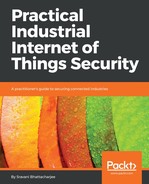STRIDE, developed by Microsoft, is a model to identify and classify threats. The STRIDE model has also been extended to include IoT threats (MST-STR), and can be applied to IIoT use cases. The STRIDE acronym represents the following types of threat:
- Spoofing identity: A type of threat where a person or device uses another person's credentials, for example, login and password, certificate, and so on, to gain access to an otherwise inaccessible system. A device can use a spoofed device ID.
- Tampering with data: Altering the data to mount an attack. The data could be related to a device, protocol fields, unencrypted data in motion, and so on.
- Repudiation: When a person or a device is able to refuse to be involved in a particular transaction or event; and when it is not possible to prove otherwise. In the case of a security breach, the inability to trace it to the responsible person or device is in itself a threat.
- Information disclosure: Exposure of information to individuals who are not authorized to have access to it. In the IIoT context, this could mean when sensor or operational data is accessible to an adversary planning to launch an attack.
- Denial of service: These threats prevent legitimate users or devices from accessing server (compute) or network resources. Exploits that slow down system performance to unacceptable levels can also be considered as a form of denial of service attack.
- Elevation of privilege: An unprivileged user penetrates the security defenses to gain a sufficient level of trust and access privileges to compromise or damage the targeted system.
